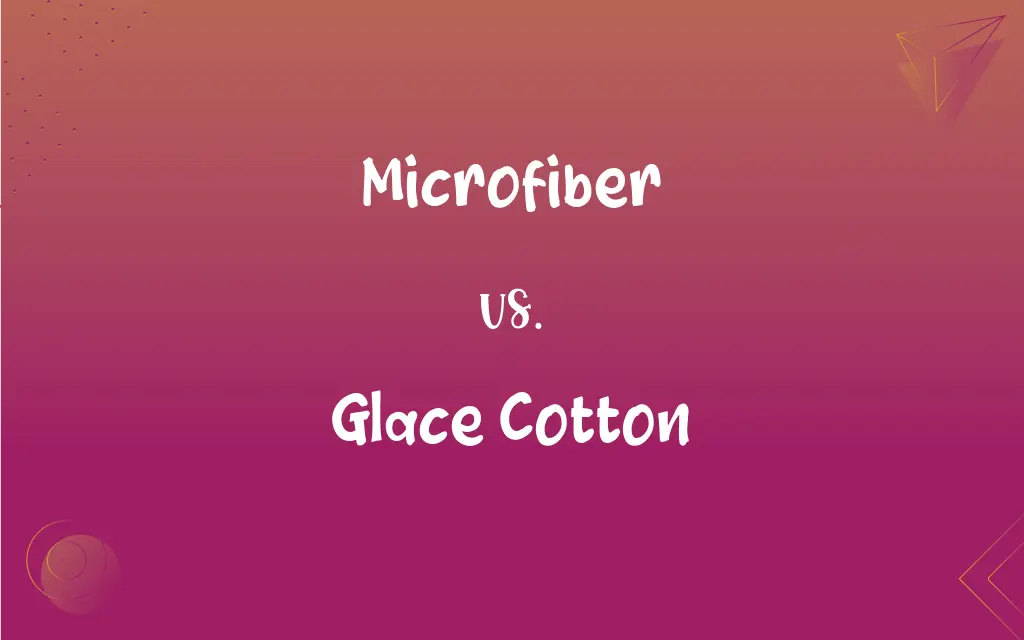Microfiber vs. Glace Cotton: What's the Difference?
Edited by Aimie Carlson || By Harlon Moss || Published on December 17, 2023
Microfiber is a fine synthetic fiber known for its softness and durability, while glace cotton is a type of cotton with a shiny, smooth finish.

Key Differences
Microfiber is made from finely woven synthetic fibers, often polyester or nylon, giving it exceptional softness and strength. Glace cotton, on the other hand, is a natural cotton fabric treated to have a glossy finish, enhancing its smoothness and visual appeal.
Microfiber is known for its ultra-soft texture, making it ideal for clothing and linens. Glace cotton, while also soft, has a distinctive silky sheen and smooth surface, often preferred for decorative textiles.
Microfiber's synthetic composition makes it highly durable and easy to care for, often resistant to wrinkles and shrinkage. Glace cotton, being natural, requires more careful maintenance to preserve its sheen and can be more prone to wrinkling.
Microfiber is widely used in sportswear, upholstery, and cleaning products due to its moisture-wicking and absorbent properties. Glace cotton, with its attractive finish, is often chosen for luxury bedding, curtains, and apparel.
Microfiber, as a synthetic material, can contribute to microplastic pollution, whereas glace cotton, a natural fabric, is biodegradable but its production may involve higher water and pesticide usage.
ADVERTISEMENT
Comparison Chart
Material Origin
Synthetic (polyester, nylon)
Natural (cotton)
Texture
Extremely soft, smooth
Smooth with a glossy sheen
Durability
High durability, less prone to wrinkling
Moderate, prone to wrinkling
Care and Maintenance
Easy to care, machine washable
Requires gentle care, may need ironing
Environmental Impact
Potential microplastic pollution
Biodegradable but higher water usage in production
ADVERTISEMENT
Microfiber and Glace Cotton Definitions
Microfiber
Microfiber is a fine synthetic textile made from ultra-thin fibers.
The microfiber cloth effortlessly cleaned the lenses without leaving any scratches.
Glace Cotton
Glace cotton, due to its finish, is ideal for decorative textiles.
The designer used glace cotton fabric for the accent pillows to add a touch of elegance.
Microfiber
Microfiber is used in clothing for its moisture-wicking properties.
His microfiber running shirt kept him dry during the marathon.
Glace Cotton
Glace cotton is often used in high-end bedding for its smoothness.
Their new glace cotton bed sheets were both beautiful and cozy.
Microfiber
Microfiber refers to a high-density fabric known for its softness.
Her new microfiber sheets felt incredibly soft against her skin.
Glace Cotton
Glace cotton is a type of cotton fabric with a glossy, smooth finish.
The glace cotton tablecloth added an elegant touch to the dining room.
Microfiber
Microfiber, due to its fine fibers, is often used in cleaning products.
The microfiber mop easily picked up dust and dirt from the floor.
Glace Cotton
Glace cotton is known for its visually appealing texture and comfort.
The glace cotton curtains in the hotel room looked luxurious yet felt comfortable.
Microfiber
Microfiber is a popular choice for upholstery due to its durability and texture.
The new sofa was covered in a luxurious, dark blue microfiber.
Glace Cotton
Glace cotton refers to cotton treated to have a sheen and silky surface.
Her dress made of glace cotton shimmered subtly in the light.
Microfiber
An extremely fine synthetic fiber that can be woven or knit into textiles with the texture and drape of natural-fiber cloth but with enhanced washability, breathability, and water repellancy.
Microfiber
(American spelling) Very fine synthetic fiber; cloth made of such fiber.
The spilled wine hadn't stained the microfiber couch.
FAQs
Are microfiber products easy to care for?
Yes, they are machine washable and resistant to wrinkles.
Can glace cotton be machine washed?
Yes, but it often requires gentle care and may need ironing.
How do microfiber and glace cotton differ in texture?
Microfiber is ultra-soft and smooth, while glace cotton has a silky sheen.
What is microfiber?
A synthetic fabric made from extremely fine fibers, offering softness and durability.
What is glace cotton?
A natural cotton fabric treated to have a shiny, smooth finish.
Does glace cotton require special maintenance?
It needs careful washing and ironing to maintain its sheen.
Is microfiber environmentally friendly?
It can contribute to microplastic pollution, which is a concern.
How is the sheen on glace cotton achieved?
Through a special finishing process that gives it a glossy look.
Does glace cotton shrink?
It can, especially if not cared for properly.
Is microfiber good for sportswear?
Yes, its moisture-wicking properties make it ideal for sportswear.
Is microfiber more durable than glace cotton?
Generally, yes, due to its synthetic composition.
Do microfiber cloths clean effectively?
Yes, they are excellent for cleaning due to their fine fibers.
Is glace cotton suitable for sensitive skin?
Yes, its smooth finish is generally comfortable for sensitive skin.
How is microfiber made?
By weaving extremely fine synthetic fibers, like polyester or nylon.
What are common uses for glace cotton?
Luxury bedding, curtains, and decorative apparel.
Can microfiber cause allergies?
It’s unlikely, as it doesn’t harbor dust mites easily.
Is microfiber suitable for baby products?
Yes, due to its softness and hypoallergenic properties.
Can glace cotton fabrics be dyed?
Yes, they can be dyed in various colors.
Can glace cotton be used for outdoor textiles?
It’s less common due to its delicate nature and need for care.
Is microfiber furniture easy to maintain?
Yes, it’s stain-resistant and easy to clean.
About Author
Written by
Harlon MossHarlon is a seasoned quality moderator and accomplished content writer for Difference Wiki. An alumnus of the prestigious University of California, he earned his degree in Computer Science. Leveraging his academic background, Harlon brings a meticulous and informed perspective to his work, ensuring content accuracy and excellence.
Edited by
Aimie CarlsonAimie Carlson, holding a master's degree in English literature, is a fervent English language enthusiast. She lends her writing talents to Difference Wiki, a prominent website that specializes in comparisons, offering readers insightful analyses that both captivate and inform.

































































